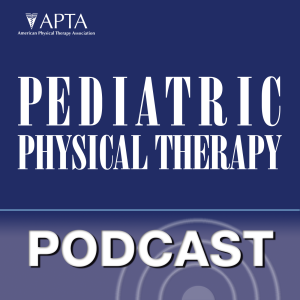
1. The Geek Perspective: Answering the Call for Advanced Technology in Research Inquiry Related to Pediatric Brain Injury and Motor Disability
Michael Wininger, PhD; Peter Pidcoe, PT, DPT, PhD
Department of Rehabilitation Sciences (Dr Wininger), University of Hartford, West Hartford, Connecticut
This report announces that engineers would just love to help you monitor or control any aspect of your patient care. So if you didn’t know to whom you could turn to for a technical fix: the answer is: Turn to a Geek! In the podcast Mike Wininger says Geeks have lots of tricks up their sleeves to help patients such as children with brain injury and motor disability.
2. Creative Dance Practice Improves Postural Control in a Child With Cerebral Palsy
Kate Stribling, PT, DPT; Jennifer Christy, PT, PhDOregon Health and Science University (Dr. Stribling), Portland, Oregon; University of Alabama at Birmingham (Dr. Christy), Birmingham, Alabama.
Dance has healing power! Kate Stribling tells the podcast how she looked into the role of creative dance practice for improving postural control in a child with cerebral palsy in her research in Alabama.
3. Uptake of the Congenital Muscular Torticollis Clinical Practice Guideline Into Pediatric Practice
Sandra Kaplan, PT, DPT, PhD; Robin Dole, PT, DPT, EdD, PCS; Joseph Schreiber, PT, PhD
Department of Rehabilitation and Movement Science (Dr Kaplan), Rutgers, The State University of New Jersey, Newark, New Jersey; School of Human Service Professions (Dr Dole), Institute for Physical Therapy Education, Widener University, Chester, Pennsylvania; Chatham University (Dr Schreiber), Pittsburgh, Pennsylvania.
Experts at the Physical Therapy Association have pooled their recommendations to form guidelines for the clinical approach to congenital muscular torticollis. Sandra Kaplan tells the podcast how she took on the difficult task of doing a survey to analyze the uptake of the guidelines and to see what benefits came out.
4. A Novel Mobility Device to Improve Walking for a Child With Cerebral Palsy
Andrea Fergus, PT, PhDShenandoah University, Winchester, Virginia.
A device called the Upsee that helps carers teach children how to walk is described as: a “dual orthotic device”. Every time the adult takes a step so does the child because the Upsee has sandals for both of them that are physically attached. At Shenandoah University in Winchester, Virginia, Andrea Fergus has been using it to help a child with cerebral palsy. She tells the podcast about the positive experiences she’s had with the device so far.
5. Gross motor outcomes after dynamic weight bearing in two children with trunk hypotonia: a case series. Dynamic weight bearing in trunk hypotonia
Elizabeth M. Ardolino, PT, PhD, University of St. Augustine for Health Sciences, 5401 LaCrosse Ave, Austin, TX 78739 (eardolino@usa.edu).]
A second research paper in Pediatric Physical Therapy journal reports on using the Upsee device in two children with truncal hypotonia. Elizabeth Ardolino tells the podcast how this helped.
6. Determining Need for School-Based Physical Therapy Under IDEA: Commonalities Across Practice Guidelines
Carlo Vialu, PT, MBA; Maura Doyle, PT, DPT, MS, PCSSt Mary’s Home Care (Mr Vialu), New York, New York; Physical Therapy Department (Dr Doyle), New York City Department of Education, New York,
New York.
The United States helps citizens with disabilities by following the Individuals with Disabilities Education Act—IDEA for short. This provides students in public education access to a number of services—among them physical therapy. What IDEA does not do, however, is to specify precisely what the physical therapy should consist of. In the podcast Carlo Vialu picks up the baton.
7. Comparing Unimanual and Bimanual Training in Upper Extremity Function in Children With Unilateral Cerebral Palsy
Susan E. Klepper, PT, MS, PhD; Debra Clayton Krasinski, PT, MS, PhD; Meaghan C. Gilb, PT, DPT, PCS; Nashwa Khalil, PT, DPT, NCS
Program in Physical Therapy and Department of Rehabilitation and Regenerative Medicine (Drs Klepper and Krasinski), Columbia University, New York; Rusk Institute (Dr. Khalil), New York University Medical Center, New York; and Children’s Health (Dr. Gilb), Children’s Medical Center of Dallas, Dallas, Texas.
Progress in training children with unilateral cerebral palsy to use their upper extremities is under scrutiny in Pediatric Physical Therapy journal and in the podcast in which Susan Klepper throws light on whether children should try to use the side that’s affected without having their other arm available to help.
More Episodes
 2024-07-17
2024-07-17
 2024-04-02
2024-04-02
 2023-09-20
2023-09-20
 2023-06-30
2023-06-30
 2023-03-28
2023-03-28
 2023-01-06
2023-01-06
 2022-09-29
2022-09-29
 2022-06-24
2022-06-24
 2022-04-04
2022-04-04
 2021-12-22
2021-12-22
 2021-10-01
2021-10-01
 2021-06-29
2021-06-29
 2021-03-30
2021-03-30
 2020-12-18
2020-12-18
 2020-10-01
2020-10-01
 2020-06-30
2020-06-30
 2020-03-27
2020-03-27
 2019-12-20
2019-12-20
 2019-09-27
2019-09-27
 2019-06-27
2019-06-27
Create your
podcast in
minutes
- Full-featured podcast site
- Unlimited storage and bandwidth
- Comprehensive podcast stats
- Distribute to Apple Podcasts, Spotify, and more
- Make money with your podcast
It is Free
- Privacy Policy
- Cookie Policy
- Terms of Use
- Consent Preferences
- Copyright © 2015-2024 Podbean.com





